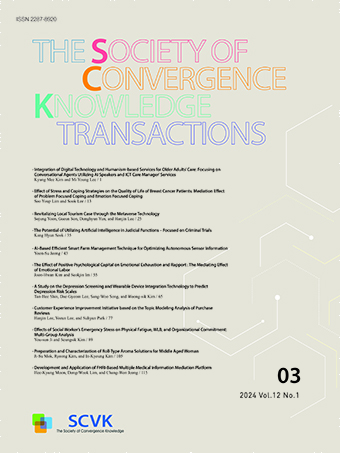Research Article
Abstract
References
Information
급격한 도시화·산업화로 인하여 수환경에 유입되는 오염물질의 종류와 양이 증가하고, 수환경 보전에 대한 관심이 높아짐에 따라 수질오염의 발생을 줄이고 제거하는 연구들과 함께 수환경에 오염물질들이 유출되었을 때 이를 감지하고 측정하여 효과적으로 대응하는 방안에 대한 연구들 또한 활발히 진행되고 있다. 이에 따라 실시간으로 환경을 모니터링하고 이상 징후 감지 시 빠르게 대응을 할 수 있도록 하는 여러 종류의 장치들이 개발되고 있다. 센서 기술의 발달과 함께 모니터링 기술이 성장하였으며, 수질 분야에서도 지난 십여 년간 많은 기술개발로 수질 모니터링이 빠른 발전을 이루었다. 현재 하수처리장에 설치되어 있는 수질 측정센서들은 생물반응조 내 미생물, 부유물질 등의 협잡물로 인해 측정 정확도가 낮고 장기간 사용하지 못하는 단점이 있다. 본 연구에서는 하폐수의 수질을 측정할 수 있는 상용화된 측정 센서 및 분석 장비의 기술 및 원리를 알아보고 각각의 측정 대상 수질항목에 대하여 조사 및 분석을 하였다. 수질 측정센서에 협잡물 부착방지 시스템을 적용하여 하수처리장 전용 자동측정장치를 개발하고자 다양한 세척 또는 센서보호 시스템을 고안하여 검토하였다.
As interest in the water environment preservation increases, many researchers have studied to prevent and reduce environmental contaminations. It was studied to detect and measure for the contaminants spilled into the environment in order to respond effectively. A lot of instruments are developed to monitor the environment in real time and to respond quickly when abnormality is detected. Monitoring technology which is observing and recording target materials has grown with the development of sensor technology. Water quality monitoring has developed rapidly over the past decade with new technology. Water quality measuring sensors currently installed in sewage treatment plants have low measuring accuracy and can not be used for a long time due to contaminants such as microorganisms and suspended substances in the bioreactor. In this paper, we describe the technical principle of commercialized measuring sensors and analyzers that can measure qualities of water and wastewater. we explain the target materials which is measured by each sensors and analyzers. We also devised and reviewed various sensor cleaning or protection systems to develop an automatic measuring device exclusively for sewage treatment plants by applying the anti-fog adhesion system to the water quality sensor.
- C. K. Ho, A. Robinson, D. R. Miller and M. J. Davis, “Overview of sensors and needs for environmental monitoring”, Sensors, 5, 4-37, 2005.10.3390/s5010004
- 박필주, 최성수, 윤문섭, 김상일, “수질센서/환경칩 기술동향”, 2011.
- 한혜진, 김종성. "사물인터넷 (IoT) 을 활용한 스마트 물환경관리 방안 및 정책기반 마련 연구." 기본연구보고서 2016 (2016): 1-205.
- 송미영, 최동진, 정복선. "경기도 물 관련 규제 실태 분석 및 발전 방안." 정책연구 (2016): 1-102.
- 조용현, 김연은, 김희영. "개인하수처리시설 성능검사의 효율적 개선방안 연구." 한국수처리학회지 25.3 (2017): 99-108.10.17640/KSWST.2017.25.3.99
- 손승우, 윤정호, 전형진, 이종민, 문지원, 김태현. “환경감시업무 지원을 위한 환경정보시스템 분석과 정보 활용도 평가.” 한국산학기술학회 논문지, (2017): 726-736.
- G. Olsson, M. Nielsen, Z. Yuan, A. Lynggaard-Jensen, J-P Steyer, “Instrumentation, control and automation in wastewater systems”, 2005.
- P. A. Vanrolleghem and D. S. Lee, “On-line monitoring equipment for wastewater treatment processes: state of the art”, Wat. Sci. Tech., 47, 1-34, 2003.10.2166/wst.2003.0074
- R. A. Dobbs, R. H. Wise and R. B. Dean, “The use of ultra-violet absorbance for monitoring the total organic carbon of water and wastewater”, Wat. Res., 6, 1173-1180, 1972.10.1016/0043-1354(72)90017-6
- H. A. Thomsen, and M. K. Nielsen, “Practical experience with on-line measurements of NH4+, NO3-, PO43-, redox, MLSS and SS in advanced activated sludge plants”, The City and The water, 2, 378-388, 1992.
- H. Wacheux, S. Da Silva and J. Lesavre, “ Inventory and assessment of automatic nitrate analyzers for urban sewage works”, Wat. Sci. Tech., 28, 489-498, 1993.10.2166/wst.1993.0689
- C. J. Gippel, “Potential of turbidity monitoring for measuring the transport of suspended-solids in streams”, Hydrol. Proc., 9(1), 83-87, 1995.10.1002/hyp.3360090108
- J. Pfannkuche and A. Schimdt, “Determination of suspended particulate matter concentration from turbidity measurements: particle size effects and calibration procedures”, Hydrol. Proc. 17(10), 1951-1963, 2003.10.1002/hyp.1220
- H. Wacheux, J.-L. Million, C. Guillo and E. Alves, “NH4+ automatic analysers for wastewater treatment plant: evaluation test at laboratory and field level”, Wat. Sci. Tech., 33(1), 193-201. 1996.10.2166/wst.1996.0019
- H. Aspegren, U. Nyberg andB. Andersson, “Integration of on-line instruments in the practical operation of the Klagshamn wastewater treatment plant”, Med. Fac. Landbouww. Univ. Gent, 58, 2019-2028, 1993.
- G. G. PAtry and I. Takacs, “ Modelling, simulation and control of large-scale watewater treatment plants: an integrated approach”, Med. Fac. Landbouww. Univ. Gent, 60, 2335-2343, 1995.
- K. Cammann and A. Schroeder, “ Working with Ion-Selective Electrodes”, Apringer Verlag, 1979.10.1007/978-3-642-67276-7
- YSI, https://www.ysi.com/
- APHA, “ Standard methods for the examination of water and wastewater”, 18th edition.
- S. Winkler, L. Rieger, E. Saracevic, A. Pressl, G. Gruber, “ Applicattion of ion sensitive sensors in water quality monitoring”, Wat. Sci. Tech., 50(11), 105-114, 2004.10.2166/wst.2004.0678
- B. C. Blake-Coleman, D. J. Clarke, M. R. Calder and S. C. Moody “Determination of reactor biomass by acoustic-resonance densitometry”, Biotech. Bioeng., 28, 1241-1249, 1986.10.1002/bit.26028081618555452
- A. Zips and U. Faust, “Determination of biomass by ultrasonic measurements”, Appl. Environ. Microbiol., 55, 1801-1807, 1989.10.1128/AEM.55.7.1801-1807.1989 16347973 PMC202953
- L. Olsson and J. Nielsen, “ On-line and in situ monitoring of biomass in submerged cultivations” TIBTECH, 15, 517-522, 1997.10.1016/S0167-7799(97)01136-0
- C. L. Davey, H. M. Davey, D. B. Kell and R. W. Todd, “Introduction to the dielectric estimation of cellular biomass in real-time, with special emphasis on measurements at high-volume fractions”, Anal. Chim. Acta., 279, 155-161, 1993.10.1016/0003-2670(93)85078-X
- E. J. November and J. F. Van Impe, “On-line viable biomass measurement and estimation of the specific growth rate of activated sludge from municipal wastewater treatment”, Wat. Sci. Tech., 43(7), 97-102, 2001.10.2166/wst.2001.0399
- 하크코리아, https://kr.hach.com/
- Publisher :The Society of Convergence Knowledge
- Publisher(Ko) :융복합지식학회
- Journal Title :The Society of Convergence Knowledge Transactions
- Journal Title(Ko) :융복합지식학회논문지
- Volume : 7
- No :4
- Pages :103-113
- DOI :https://doi.org/10.22716/sckt.2019.7.4.056




 The Society of Convergence Knowledge Transactions
The Society of Convergence Knowledge Transactions







